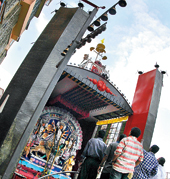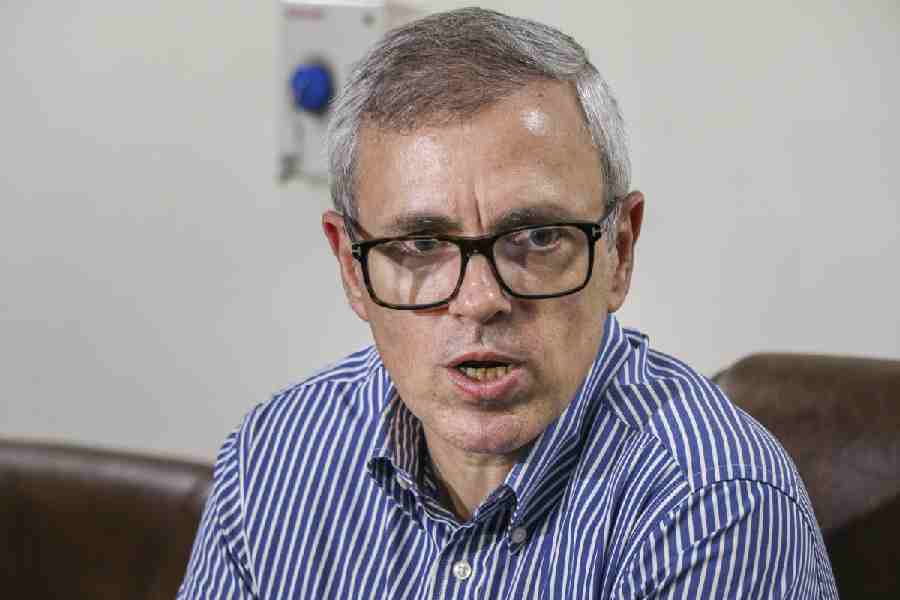 |
| Artist Partha Dasgupta’s installations at a Behala puja |
nA Durga puja pandal of hammered iron sheets; Adarsha Palli, Behala, 2005.
nAnother made of fans from home and abroad, including a Victorian punkha; Barisha Jubak Brinda, 2004.
nA 60ft-tall replica of Demeter, the Greek goddess of fertility, with embryos that gave birth to natural elements; Ultadanga Jubak Brinda, 2007.
These were living, breathing site-specific installations, spawned by the vision of creative individuals: sculptor-painter-ceramic master Partha Dasgupta, painter Robin Roy and painter-printmaker Srikanta Pal.
All three are professional artists who have conceptualised, designed and created Durga pujas — and then moved away from it.
As “themes” rule the market and Puja awards have multiplied by the dozen over the past couple of years, there has been a steady decline in artists’ involvement with pujas.
“I worked on pujas because of the sheer scale it offers to showcase artistic vision. Money or any other lure was the last thing on my mind.... But it becomes a problem when people with no aesthetic background whatsoever try and interfere in your work,” says Robin Roy, whose 2004 work at a Behala puja won an award.
“It takes at least half the year to plan a puja. Creating it requires teamwork. I felt there was little co-operation from the organisers. They gave me money and freedom but not the cooperation needed to transform my vision into reality. A puja, which should reflect harmony and unity in a community, cannot be successful without a concerted team effort,” Roy adds.
Then there was the rat race for awards. “I was facing the heat of competition without actually signing up for any contest. It was an awkward situation. I lost interest in it all,” says Roy, who still enjoys his Puja and loves watching pandals.
Unlike Roy, Srikanta Pal worked for money as a student to fund his own work for the rest of the year — right from his undergraduate days at Rabindra Bharati University in 1995 till he moved to MS University in Baroda for his masters. But money was not the only thing on his mind.
“I worked on pujas for three consecutive years till 1997 but the rush for awards that started in the end-1990s spoiled the spirit,” recalls Pal.
What irked him most was the tendency of a few resourceful persons with no appreciation of art trying to dictate terms. “An organising committee member who brought in bulk advertisements thought it was his right to offer suggestions on how to design the puja,” says Pal.
Then payments went awry. “Either we were paid less than what was promised or not paid on time.”
On his return from Baroda, Pal had only offered a design concept to his para puja in Ultadanga in 2007. “I just don’t feel the Puja spirit of harmony in a community. It’s all about which prizes you bag and which channel beams your puja. In this situation, a banker is perhaps more adept at talking about art than a professional artist,” rues Pal.
Partha Dasgupta had worked with a Barisha puja in 2002-03 and a Behala puja in 2005-06 — works that were way ahead of their times. “I never worked on a puja for money. It was always about getting the work done on a larger scale, which I couldn’t finance myself, and create one-of-a-kind site-specific installations,” says Dasgupta.
Incidentally, the pujas he created won awards, and that was the beginning of an end. Competition came drumming in, with its prizes up for grabs.
“I basically lost the heart to work, following interference from organisers and the uneasy feeling of being in a competition without my consent. I also realised that in the rush of artists creating pujas, very few were full-time professionals working throughout the year. Consequently, there was little groundwork being done in creating a puja, with ‘themes’ being handled in a perfunctory manner.”
Shifting the blame onto the organisers is easy, but Dasgupta feels it is the artist’s responsibility to choose between financial rewards and showcasing creativity.
Sanatan Dinda has been a front-runner in creating Durga pujas — his exquisitely crafted pandals and protimas having won almost all awards on the Puja platter. He started with his para puja in Hatibagan in 1998 and then went on to create another nearby.
“I am creating a puja this year again after 2007,” says Dinda. He agrees with Dasgupta about minimal groundwork by artists. “One needs to know the history of Durga puja. Whether you get craftsmen to work on themes or replicate pyramids, it won’t work unless you know why you are doing what you are doing.”










